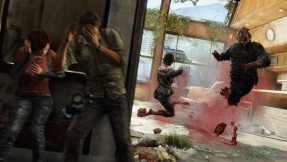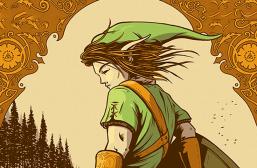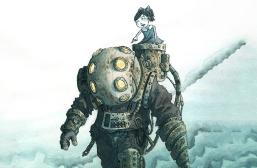Video Game Violence and Narrative Dissonance
Skulls crunch beneath the treads of your sick Bone Tank as it rolls across a shattered landscape. The precipice of Blood Hill is so close you can taste it. You’ve killed thousands of men on the way up this hill and you’re ready for that sweet bloody dessert you know is waiting at the top. But what’s this? Two Flesh-Rakers have risen out of a pile of human corpses, their manifold jaws undulate in time with the clicks that issue forth from their stolen human vocal chords. You don’t have much time to react, but you’ve never really needed much.
Pulling your S-Class Brain Choker out of its stylish leather holster you take aim and deliver swift justice right between the eye analogues. The Flesh-Rakers burst in a cloud of blood and bone mist. Blood Hill will soon be yours! As you reach the top you find yourself face to face with general Norm and the Cheers army. Norm is the third of the seven generals in Guy Fieri’s Infinite Reich and the boss of Blood Hill. His army of all too human combatants must fall. This is no problem for you because you are Sadeyes Mchardpast AKA Gun Guy, the guy with the guns, the master of sick moves.
You pull out your secret weapon, a handheld sun. While pitching it into the center of Norm’s army you convert your Bone Tank into it’s gnarliest form, the Skull Cycle and ride down the vertical face of blood hill. The mushroom cloud somehow reflects in the lenses of your sunglasses even though it is actually behind you. Ten thousand people now lie dead by your hand. What do you care, nothing can stop you.
Except your tragic past, of course.
That will stop you in every cutscene of your stupid white-guy face bunching up with CG sadness over the loss of your beloved childhood dog, Chewber. Ever since that day, you swore that violence was never the answer, and that you would always find another way to solve your problems.
Seems a little off, right?
Such is the plight of the protagonist of the big-budget action game. While it seems that they can kill and kill and kill to the point of no return, put them in any scene that’s relevant to the story and suddenly they’re supposedly more than the psychopath they’ve been presented as. They’re given pasts full of hardship that supposedly make them relatable. Maybe they’ve lost someone they loved or were forced to make a choice that turned out badly for them. Often times they have an aversion to violence and are only taking up the fight because circumstances have forced them to.
This creates narrative dissonance. The stated actions and personality traits of the character are contradicted by what the player must do as that character in order to advance the story of the game. It doesn’t make sense for Sadeyes to annihilate Norm’s army just after the cutscene where he explained to another character how he could never fight again. Perhaps he fights anyway, even though he doesn’t want to, but after ripping a man’s skull out of his face for the fortieth time in a row, it gets a little hard to believe.
While many games in the indie scene move against this kind of representation of violence; The Walking Dead, Lovely Planet, and Papers, Please for example. But in the realm of triple-A development, this is definitely the norm. Advertisements for games such as Bioshock Infinite put forth the extremity of the content as a main selling point through the use of dynamic action and loud guitar solos, while the actual content of the game is supposed to take a more contemplative route.
Violent games tend to give emotional story points as rewards for completing non-emotional fight sequences. The player commit atrocities while controlling the character, but these are never referenced when control is taken away from the player. The character controlled by the player is seemingly abstracted away from their actions during fight scenes so they can be ignored by the character during story scenes. This results in it seeming as if there are two separate versions of the character. One appearing during story points, and the other being controlled by the player.

Booker from Bioshock Infinite is a veteran struggling with PTSD whose reason for going to Columbia is to save his beloved daughter. He then finds himself protecting a young woman because he feels that protecting someone is worth doing. Clearly he’s supposed to be sympathetic. More than that, he’s supposed to be a good person. But as soon as the player is given control over him, they are forced to ram his skyhook into the throat of a nearby police officer, turning his bones into silly putty.
How is the player supposed to think of Booker’s story when they are presented with two conflicting versions of the character? Clearly they aren’t supposed to see him as a psychopath incapable of human interaction, but he clearly has little regard for the lives of those who stand in the way of his goal. His goals are based entirely on empathy, but apparently the only way he can realize those goals is by acting without any.
The Last of Us is a game that manages to avoid a large amount of this dissonance. The Last of Us puts us in control of another character in charge of protecting a human being. Joel’s goal is to keep Ellie alive so she might help in creating a cure for the disease that turns people into the zombie-like clickers that populate the dark areas of The Last of Us.
Along the way, the two face many situations where violence seems to be the only way for them to progress from one area to the next. Either they confront hordes of clickers or groups of living people who wish to do them harm for one reason or another. When faced by the clickers, violence does not seem to be such an abstract option in relation to the goals of the characters.

The clickers are monsters, they no longer occupy a space where the characters or player would have to worry about the consequences of killing another human being. Even though these creatures were once humans, they have been so far removed from this state that they barely even resemble humans by the time you encounter them.
Where the dissonance may come into play is with the interactions with bandits and the like. But in these moments, the developers at Naughty Dog seem to have taken this into consideration. In The Last of Us there is rarely an encounter in which Joel must kill all the enemies he is faced with. While it is entirely possible to turn Joel into a mindless killing machine, it is not necessary.
The player has a choice of whether or not they want to sneak past their enemies, or fight them directly. The entire game without killing any of the human mobs. Players do not have to fight relentlessly in order to advance the emotional plot of the game.
This is another large issue that comes from games with such a heavy focus on violence. If they don’t create an extremely stylized world, such as the new Wolfenstein, while simultaneously not trying to impart a grand vision of morality, the violence is can still be seen as rather dissonant. How is the player supposed to believe that Joel is not only psychically prepared to kill hundreds of human beings, but physically prepared as well?
Violence creates issues when trying to deliver a story that is about something other than violence. When it is the main kind of verb that player is presented with, it tends to overshadow other parts of a game, maybe even parts that the developers though of as more important. This is because what a player takes away from a game will be what they interacted with the most. Video games are about interaction, and it is through those interactions that a game’s strongest messages will be found. So by making your main interaction violence, the main take away will be the violence as well. Bioshock Infinite is no longer a story of race, religion, and love; but instead one about a cool guy who shot a lot of magic out of his arms.
Games have an extra degree of characterization that isn’t present in other forms of media, like books or movies. Games have the extra dimension of player control over the character. Most other art forms develop characters by showing us what they do.The added control a player has allows for the them to act in a way that adds or detracts from that development.

Some of these detractors are out of the developers control. You can have a character who is supposed to be smart, but the player can choose to have them walk into a wall over and over again for an hour. The developer can’t stop the player from doing this, so this is dissonance that cannot be avoided. The bad form of dissonance comes from the tools the developer has given to the player. Like the extreme violence in Bioshock Infinite.
Characters are more defined by their actions than their words. Spider-Man is virtuous because he acts virtuously towards others. He is against killing. This is known because Spider-Man never kills anyone. He is funny. This is because Spider-Man makes jokes. Spider-Man doesn’t claim to be against killing, then kill a man, and if he were to do so, the other characters wouldn’t ignore it, and Spider-Man himself definitely wouldn’t ignore it! However, this seems to often be the case with how characters in video games behave.
The thing is, this kind of dissonance isn’t unavoidable. There are a few ways that developers might add a little more realism to characters that are supposed to embody something that resembles a real person.
Give the player more to do than murder
While adding a “hug” button into games isn’t necessary, it would be nice if players were given a way of interacting with the world in these games that wasn’t just killing enemies. Take our hypothetical protagonist Sadeyes for example. What if instead of forcing the player to reduce Norm’s army to nuclear ash, he could has out a peace treaty with them, gaining new allies. Or just avoid the battle altogether. Let Norm keep Blood Hill. Sadeyes has more important business to attend to, like writing soliloquies in honor of the passed Chewber. Whatever else he could do, at least it could be something that made more sense with who the character is supposed to be.
If a character is smart, make the player solve puzzles. If a character is charismatic, let the player talk their way out of fights. If the character actively claims to be against killing, don’t make the character kill literally everyone. Don’t just say that the character is these things because of how they interact with other characters in cutscenes, make the player feel as if they are able to contribute to these traits within the character.
If the aim of your game is an endless stream of killing, make your characters people who might do that. While Gears of War games don’t necessarily have well-rounded characters, it is it believable that they exist in their world. Who better to destroy endless streams of Locusts than a group of hearty space-bros, their chests full of so much muscle that it is nothing less than a miracle that they can even keep their shirts on.
The experience of the player should reflect the experience of the character within the game. You shouldn’t feel as if there are two separate versions of the character, the one controlled by the player, and the one saying the dialogue. The best way to do this is by making the player and the character seem more unified. If one of the goals of the story of your game is empathy, then you have to somehow include that empathy in the basic loop of the game.
Make killing matter
Make the player find justification for killing so many enemies. If the character starts out with notions of the sanctity of life, make sure the character knows they have broken them. In Heavy Rain, there is a moment in which one of the characters can kill someone who it turns out, shouldn’t be killed. If they kill this person, the character is deeply effected by this act for the rest of the game.
So Sadeyes’ game isn’t set in a sandbox world, the player has to move down rails, and receive a set story a la Half-Life. There’s nothing wrong with making a game like this, many games benefit from this kind of narrative. If Sadeyes is against killing, making him kill people should bother him. Not just in the cutscenes. Not only when it’s convenient to the story. Not only when you need him to look sensitive for the camera. It should always bother him. It should bother him when he knows he’s going to have to do it, it should bother him when he’s doing it, and it should bother him after he’s done it. Having the character flip back and forth between two modes of being makes the character’s convictions comical.

By making the character care about the fact they have killed someone, the player cares as well. Why? Because it affects the experience of playing the game. A way that this could be implemented into more mainstream games is through the introduction of some sort of stress system. The more violence committed by the character in the game, the more stress they accumulate. This could effect the player’s experience in many ways. It may make their aim slightly shakier, but it may also increase the speed at which they could use their weapon. It could give the character some sort of adrenaline boost that makes them less susceptible to damage, but makes it harder for the player to see the battlefield. If it at least effected how the character behaved in story situations, it would clear that the player’s actions have consequences.
Papers, Please is a game in which any act of violence will lie heavily on the player’s conscience. For those who don’t know, Papers, Please is a game in which the player takes control of a border checkpoint in a fiction version of the USSR called Arstotzka. It is the player’s job to make sure that everyone entering the country has the right papers in order to cross the border.
Within the game there is a moment in which one of the border guards approaches the player and tells them that they will give them extra money for every person that have detained, no matter the reason. A common reason to have someone detained is if they are carrying contraband on their person. Many of the people you catch carrying said contraband will tell you that it is medicine that they need in order to live. While the player never sees what happens to those they have detained, because of the nature of Arstotzka’s government, you can assume that it isn’t very kind. The moment the player chooses to have someone taken away, they immediately feel the weight of their violent act.
A similar moment can be found in the first act of violence committed by the player in Bioshock Infinite. The player has spent the first hour or so wandering around an idyllic city floating in the clouds. They’ve participated in a carnival and listened to a barbershop quartet sing an out of time rendition of the Beach Boy’s “God Only Knows.” You almost forget that the game’s central mechanics will be combat-based. Then everything turns. The people of the city recognize Booker as an outsider and attempt to arrest him. The only response he has is to plunge a Sky-Hook into his assailants face, spraying viscera onto the screen in a so-far unprecedented scene of gore and terror.
Give the player a choice and make the choice matter
What if Sadeyes didn’t kill Norm on Blood Hill? What if he didn’t kill anyone on Blood Hill? What if he didn’t even go to Blood Hill because the player thought it would be more fun to do something else during that time period. This would surely have some consequences. Alright, so Norm now sits on his throne of bones, a bone-throne if you will, atop Blood Hill. Blood Hill happens to have a great view of Unprotected Valley, where a group of people have set up town. Norm uses his advantageous position to dominate the town and now has the people living there enslaved in his salt mine. Which sucks for Sadeyes because there was a really good armor shop in that town. While Sadeyes is against violent onslaught, he is also against slavery, and the player is for cheap armor. Now because of the choice the player made, they must either find a way to free the town, be it through assassination or clever political manipulation. Either way, they made a choice in the game, and the choice actually behaved the way a choice does in real life. It had consequences.
The game Deus Ex: Human Revolution puts the player in a world riddled with social and political issues (even if it doesn’t do the best job of addressing of them). One of the main selling points in this game was the wide variety of choices presented to the player in how they wanted to play the game. You could talk your way around many of the fights, or just simply sneak past them. Only if you wanted to, would you kill the enemies the game presented you with. And not only did the game give you the option to choose, your choice actually meant something. Killing all the enemies in one level would result in the cops not liking you after the fight was over. Why? Because they felt that the people you killed didn’t deserve to die.
When implemented poorly, you end up with Infamous. In Infamous you are given choices at choke points whose options are equivalent to “make a sandwich for a child while fondly remembering your mother” and “tear down this hospital and build a parking garage on the land.” Then, no matter what you chose, you end up progressing to the same cutscene, the only difference being if your lightning bolts are red or blue.
The choice didn’t matter, being good or evil is a superficial option because it doesn’t actually make a difference in how you end up playing the game. Even though the two paths give you different abilities it doesn’t matter which one you choose. Both increase the size of your explosions. Both make you shoot more lightning out of your dumb hands. Both are boring and not worth doing.
Narratives, games, violence, and why it matters
In life, violence is a powerful action, often a final one. We are taught that we shouldn’t “resort” to such modes of behavior when interacting with other beings in the world. Violence is met with consequences, it is brought to our attention, it is punished, and at the very least it is something that we are taught to avoid. When a person is violent, they have something wrong with them.
In making stories, there is a hope that they will in some way reflect facets of the real world. At the end of the day, even the most fantastic tales are meant to convey something that can be applied to real life. Harry Potter teaches us that good should triumph over evil. The exploits of Superman teach us that everyone is worth protecting. This is done by having the characters act in accordance with the values of their ultimate lessons.
Bioshock wants to teach us that it is wrong to judge others by qualities they can’t control, that no one person should hold ultimate power because it will only lead to their corruption. But how can it do so if it conveys this message to the player by having them kill ten thousand human characters with the powers of a demigod?
In all other artistic mediums, such contradiction would be seen as fatal flaws within the telling of a story, so why are they forgiven when they are present in a video game? If people want games to be able to move forward into the realms of greater art, they must be held to the same standards as those other forms of art. If there is going to be growth in the way games are made, ways in which they aren’t growing need to be brought to light.
The specter of violence hangs over video games. It is seen as necessary in order to make something playable, or fun. It is reasoned as being a standard part of video game vocabulary, something that video games have to hold onto or else they somehow lose a sense of maturity or progress. This is not the case. Games are like any other form of art, in that they are capable of myriad forms of expression. If the medium is pigeonholed, it loses it’s ability to grow. If it loses the ability to grow, it loses relevancy. If it loses relevancy, then it is lost altogether.
Works Cited
Bioshock Infinite. Novato, CA: 2K Games, 2013. Computer Software.
The Last of Us. Foster City, CA: Sony Computer Entertainment, 2013. Computer Software
What do you think? Leave a comment.











The main problem of today is parents buy their kids whatever they want and don’t look at the ratings description on the back and then they freak out when they actually see what is in the game.
At my game stop, when ever a kid tries to get a violent video game, the cashier will tell the parent this game is rated M for extreme sexual content and violence, are you sure you want to buy this? I haven’t seen one parent say no, and they are mostly of elementary school-aged kids. So even if parents are aware, they don’t care.
Video games should be treated like any other form of media. Would you let your 13 year old go to an R rated movie? Probably not. So why are you buying them Call of Duty? The vast majority of people who play violent games have no adverse reaction to it, so it’s up to parents to shelter their kids from it if they think they can’t handle it. There isn’t a violent video game problem, it’s just an easy way to take the blame and place it on something else.
I am a Gamestop store manager. My staff and I are the front line between M rated games and the public. I can say in all honesty that we are staunch defenders of the ESRB. We go down the list on the ESRB warning parents of the content and as to why it has such ratings. The general consensus is that the parents do not care that GTA has prostitutes and mass murder. I always add that I would not let my kids play any M game. After our speech about the ratings they either tell the children to pick out a less violent game, or stare at me blankly and say ”They’re just gonna play it at a friends house.” Who is to blame if the kids then play these adult games for hours and hours on end? It starts and ends with parents. Start parenting.
Since I was a kid my parents never restricted what games I could play but they always talked to me about the content in the game and how it should not be taken serious.Not enough parents do that these days.
I’ve shot over 10,000 living things dead today alone in video games. Mostly using explosive ammunition that causes my targets to explode in a bloody mess of body parts and entrails. I do this on a daily basis. Today I’ve been doing this all day.
And during the past 20+ years of playing video games, I’ve probably killed hundreds of millions of people, animals, and various monsters and creatures in video games. Using a vast variety of methods. Many of them, very brutal.
However.
I don’t know where I could get a firearm in real life. I probably wouldn’t know how to properly operate a firearm in real life. I’ve never held a firearm.
I don’t do drugs. I’ve never stolen anything. I have never committed a crime. Not even a little one.
That’s great dude! I’m glad to hear you have chosen a life of pacifism. But I don’t think that’s what I was trying to address with my article. I was talking about how a video game’s story is affected by the violence in the game, and how that violence effects the development of the player-controlled character. Sorry if that got muddled in there. I in no way think that there shouldn’t be violence in video games, I just think developers need to think a little more about how it affects the stories they are trying to tell.
Great article on a topic that’s quite pervasive in the gaming sphere. The issue with massive amounts of violence in video games is one of convenience. Aim and click is an incredibly versatile mechanic. Anyone can do it, though it requires an amount of skill to be “good” at it, which creates the potential for competitive play. It can be translated into a variety of outputs, but pointing and shooting is an obvious choice. And what do you point and shoot? Guns. Therefore, firing a weapon is an easy go-to for most games. Another question: What do you do to keep people interested in a game? Give them more to do. Those two answers combined gives us lots of shooting.
What it comes down to is imagination. Game developers either need to think outside the box and create interesting mechanics besides shooting (something which indie developers excel at). Or they can create entirely different methods of play, as you mentioned. It’d be interesting to see many different ways of overcoming obstacles in Fallout, Elder Scrolls, and other sandbox games, but it’s more easily implemented in more linear experiences.
This is as great point, and I thank you for it. The main reason I didn’t include Call of Duty or Battlefield in the article is because of their competitive nature. The games aim at creating an interesting multiplayer environment instead of a compelling story. And an honest answer to the question I pose is “making video games is hard.” It takes a lot of creativity to even make a decent game that fits into the mold of the modern gaming sphere, so creating one that breaks that mold is even harder.
i’ve been thinking about this a lot while playing skyrim – i know, i know, i’m years late, but whatever. anyway, it’s just kind of sad that such a huge, beautiful, intricate game solves basically every problem/quest/whatever with “kill them… kill them all!!!!”
i still try and approach people i meet without weapons drawn, but i’ve learned to save before talking to anyone in the overworld. most of the time they try and kill me anyway. it’s so depressing. on the plus side, i’m level 100 in archery. but what is the point of my wealth of experience points when being lord bloodkill of slaughter mountain doesn’t fill the void?? i just want to be friends with the dragons. why must i kill them, skyrim. why.
MK – I’m also just now getting through Skyrim myself. The advantage of late play is being able to search for bugged quests. 🙂
But to the point — Skyrim is an excellent example of a world that *should* have more character options than it does. I absolutely love the open-sandbox approach to Elder Scrolls worlds, but in terms of character development, that open sandbox turns into a guided path pretty quickly. Unfortunately.
I enjoyed your article. You certainly made good points regarding the context of violence within video games.
Excellent discussion.
The human mind is programmed to differentiate between reality from dreams.
The people that want to have a conversation about violence with us, assassinate people with drone strikes, condone torture, and currently have 10’s of thousands of mercenary’s in our employ.
And they really look at entertainment to point a finger?
While it’s obvious that public media of ANY type has an effect on people’s behavior, I find the connection between violent video games and the violence of the US to be dubious at best. If this were the case, then why aren’t there mass shootings in Japan, a country that produces some extremely violent video games? Why is it only the US that has such a problem with repeated instances of mass shootings? In my opinion, our children are indoctrinated at a very early age to adopt the paradigm of an “us” and “them”. In high school, the “them” are the ones that don’t fit in to the dominant archetype, and they are to be taught to conform. Conforming usually involves taunting, teasing and bullying until the “thems” comply and conform. Having grown up in England and attended British school and then moved to a US military base to finish up my schooling, I can attest to how segregated, cliquish and abusive American High Schools are. They are horrible, let me repeat that HORRIBLE places to put our still-developing impressionable youth. I was ostracized for the first 3 months simply because I dressed differently from everyone else (I was still wearing my British fashion). I was lucky enough that I was an outgoing enough person to push past that and show people that I was a likeable person. But what about the people that aren’t outgoing or are socially awkward? It’s social Darwinism in our schools. And a person can only take so much before they feel hopeless. And hopeless people are capable of anything. We should be examining the environments we raise our children in instead of trying to find a quick, easy culprit like violent video games. The cause of this is MUCH more complicated.
Great points all around, but that isn’t what I’m talking about in the article. I’m talking about the effect violence in a video game has on story of the game, and how the characters are developed. I don’t think violent video games have an effect on society.
Imagine for a second that one was able to remove all the guns, movies, and video games from society altogether.. Would violence, crime, killing stop? If your answer is no? Then obviously none of those things mentioned above are the solutions. If your answer is yes, then obviously your living in a fairy tale because violence, crime, and killing has been going on way before any of these things ever existed. Which brings me to a point, if we continue to look at things superficially, we will continue to get superficial solutions that solves nothing and thus the cycle repeats itself.
I am 61 years old. And I play video games. I have been playing video games, primarily on a PC, since 1987, when I bought a Commodore 64.
As you can imagine, at first most of the games I played were anything but violent. Truly violent games did not really exist until Wolfenstein and Doom. I’ve played all the Wolfensteins and Dooms. I recently finished Diablo III (and played both I and II when they came out). I’ve played all of the PC versions of the Call of Duty series (except for Black Ops II, which is next on my “to game” list). I am currently playing the latest Medal of Honor and have played all the PC versions of that series. I could go on and on, but you get the point.
However, I have also played strategy games such as Company of Heroes and all of the Command and Conquer and Red Alert series, which are also violent to a certain extent, but not, in my opinion, as violent as a first-person shooter. And I have also played games like Transport Tycoon, Caesar, SimCity and similar games, which are hardly violent.
In short, I enjoy games, and a enjoy a wide range of game types. I use them to unwind at the end of a day – a day that I often presents me with situations that are anything but pleasant, and rather than get violent with some moron who manages to push my buttons, I can relieve that stress digitally – and I don’t always use a violent game to relax after such a day.
In recent years, some games have created characters – your character as well as NPCs – that you actually begin to care about. It’s not always the Doom type of game where you just kill everything that moves. The ending of the first COD: Modern Warfare was the most incredible ending to a game I had ever seen up to then. It came as such a surprise I didn’t even realize that the cut scene had suddenly become “active” and I was supposed to participate in the scene – the change over was so fluid it didn’t even register the first TWO times that I was supposed to do something. And earlier when your character dies from the nuclear explosi8on – I sat there and just stared at the monitor, trying to collect my thoughts about what had just happened. That game and other since then have been more than just shoot-‘en-ups. I felt like I was making choices and affecting what was going to happen.
Because I was born in the early 1950s, I grew up playing Cowboys and Indians, and, especially “Army.” We had toy guns and even outfits and kids from the neighborhood would get together and play these “games” – these were our “first-person shooters.” The toy guns often looked as good as real guns. I had a plastic Thompson submachine gun back then that was an exact copy and the same size as the real thing, and it fired caps.
I also played with toy cowboys and Indians. I had the Marx Fort Apache, Alamo, and Civil War toy sets. I had hundreds of WWII soldiers and tanks and vehicles. I started building plastic models when I was six years old. I built mostly military aircraft, as well as warships and tanks and by the time I was sixteen I had built over 700 models. I still build models today, all military aircraft, vehicles and ships.
As a result of playing with toy soldiers and building military models, I became interested in the history of these things, and that lead me to reading about military history, especially WWII (my father and three uncles served in WWII). I was reading histories of WWII, such as John Toland’s book about the Battle of the Bulge, by the time I was 12. I would read at least a book a week, often times two a week. I would read a history book and then read a novel. Some of the novels I read in my early teens, I’m not sure that I would let someone the same age read today.
By the time I was 15, I couldn’t get my hands on enough material to satiate my interest in WWII. I bought several magazines that would have some material on WWII, but not enough for my taste. There was no exclusively WWII magazine back then. So, I thought, what the heck, I’ll publish one. I was not quite 17 when I published the first issue. It wasn’t much, barely a dozen pages, mostly mimeographed (Google it). But it was a start. Eventually that did become bigger and became a professional magazine in the mid-70s.
By the early 80s though, I started getting competition from other WWII magazines being released. I eventually switched to publishing books and today have over 160 titles in print. The majority are, of course, on a variety of WWII topics, covering battles and weapons and such, as well as many memoirs by veterans. I have, however, expanded into other eras, such as WWI, Korean War, Vietnam War and the first Gulf War in recent years. And recently have started publishing books on non-military history subjects, including even poetry.
And all that got started by playing with toy soldiers and toy guns – things that today are considered practically evil for kids to play with. Also when I was 12, I went to a summer camp. At that camp among the activities offered was riflery (and also archery). I was good at both. I had never held or fired a gun prior to that. Even the girls at the camp took riflery. Not only have I never shot anyone with anything, I have never even been in a fight – although I came close a few times, my size usually intimidates most people. I am now 6’4″ and was always the tallest kid in my class in grade school and reached 6’ in junior high, and while skinny, I was broad shouldered.
Bottom line: It’s the individual and their upbringing that matters the most. All the violent movies, books, video games, etc, does not matter if the person has been properly raised to respect others. And if a person has mental issues, as these mass shooters do, then they needed help long before they went off the deep end. We coddle kids far too much these days, to the point where we don’t realize there is a bigger problem that could get much worse. Parents need to parent and stop trying to be “best friends” with their kids. My parents never hugged or showed much physical affection towards me, but I knew I was loved by them. They cared about what I did and who I played with, etc, but when they saw me enjoying something like toy soldiers and models, they let me do my own thing and I ended up turning it into a business.
Thanks much for your post. You raise great points, one of which is inescapable. You close by saying “it’s the individual and their upbringing that matters most.”
There is nothing that we can do to ensure that anyone has any one kind of upbringing. No level of legislation, no level of involvement, and no level of talk from the gaming industry, Hollywood, the NRA, Washington or anything else can absolutely prevent bad parenting.
We are growing, things are changing and we much be diligent, but that is the big rub here: no matter how much we try and do good by our families and friends, someone else out there just doesn’t give a damn. And even great parenting isn’t a full-proof way to avoid chaos.
That’s the real vexing thing. There will always be chaos, and there will always be things that we can’t explain, and some people will choose to do the wrong things. Anyways, thanks much for taking the time to post your thoughts, really great. And good on you for being a proud 61 year-old gamer! You are awesome!
did you read the article
I really should have titled this article differently.
Great piece. When it comes to plot and system, I like exploration and the correct use of violence within the plot because it gives me a better sense of immersion. If I’m limited to what I can do then it really sticks out as a game. Or like if there are glitches it ruins it and brings me back to reality like “oh yeah I’m playing a game” if that makes any sense.
I like fun/good games, whether they’re violent or not.
Good article. The future of games looks bright.
Very interesting and I appreciate that The Artifice brings such great discussions to the forefront.
Gaming is becoming something bigger now.
-Striegel
Smart, insightful, and well-thought-out article. Thank you for starting this conversation.
I recently saw a con panel that discussed story-telling in video games, and I’ve seen mention of the narrative writing as an art form, but your point is really well-made — in order for the story-arcs to have proper narrative flow, the character’s/player’s action have to jive with the story.
It’s just so much *easier* to define success in a game by enemies slain, and that was fine in the early days of video gaming. But this is no longer the early days, and we can do better than the dissonance you’ve highlighted here. We can code more options and think bigger than this. Also, dammit, it makes the game play longer — I played through Mass Effect three times solely b/c I wanted to see all the plotlines revealed by my different choices.
The gaming industry is still in its toddler phase, and there’s so much room for growth. It’s this kind of conversation that will help it grow in the best direction. Thanks.
Just the other day, I walked into GameStop and saw 2 kids with a parent who really didn’t look like he wanted to be there. The kids picked up Bioshock and Call of duty and had their dad buy it for them. When the employee tried to explain to the dad why 9 year olds probably shouldn’t be playing those games, he just handed her a credit card and told her it was fine. The big problem with games isn’t that they are too violent, it’s that they aren’t enough parents who are properly informed or care enough. Your article is basically a perfect reason as to why parents and guardians should be more literate about the gaming world, especially with games that are mind-numbingly violent to the point where even older people get tired of it.
Great article though, I loved reading it and you had some great points!
Many parents doesnt even care or evn think about what they are getting their kids into. Some even boast that their kids love playing games but dodnt even notice what they are actually playing there. These so called action games may well affect their perception in the future.
Refreshing take on this topic, nice job!
I think it’s a matter of balance. The extremes of violence we see in recent games is not healthy for anyone, and can lead to desensitization toward violent crime. As you said, the action must be part of the storytelling, rather than sidelining the plot completely.
Great piece!
It’s interesting that while some characters may act violently in games, it isn’t so much their doing violent things that get to me, but the ambivalence towards that violence. As you pointed out The Last of Us side-steps this a bit by making the enemies into zomibe-like monsters, and in spite of the fact that a great number of the humans that Joel and Ellie kill are evil, there is still a psychological toll in the writing. I’d probably go so far as to defend Booker in Bioshock Infinite, though that may be a bit tougher.
In essence, the best way to keep a character from becoming a hypocritical killing machine who preaches the virtues of peace is to make them honest about the violence they commit and at least try to show the toll it takes on them.
I’m also fascinated by the idea of a stress mechanic. Metal Gear Solid 4 dabbled a bit in that, but I’m not sure if the stress that Snake felt was due to the combat or simply getting tired. If it was the former, then we got a glimpse of great things.
Great article Ben, it was very thought provoking.
First of all, I empathize with you in regard to the seeming inability of most commentators to process that you are not bashing video game violence. People, please thoroughly read what Ben has written. Ben, I do not think you need to change your article’s title. It is appropriate as your article deals with the dissonance created by the backstories of the characters in comparison to the actions that must be completed.
Second, I recently finished Watch Dogs and felt the same way through much of the game. While you can simply “take out” a NPC without killing (and actually be rewarded for doing so), in later sequences of the game, you have no choice but to kill when faced by several heavily-armed and well-armored enemies. And all of this violence because a little girl was killed. I am not diminishing a (virtual) child’s death, but simply putting the amount of violent retaliation in perspective. The storyline reminds us through Aiden’s sister that violence isn’t the answer, and yet you are given little choice-thus the dissonance. I believe the story would have been much more interesting if Aiden could have used all of his electronic access to cut off bank accounts or find other nonviolent means to achieve the same ends.
Where I lack knowledge is in regard to the actual code and coding process. How difficult is is it to add these types of choices? Does it add significant time to development? I also wonder if it changes the fundamental nature of a game. For instance, does it become more of an RPG than a shooter? Does that make a difference? This is an interesting and useful conversation to have.
One side note, and meant with the purest intentions of being helpful, please proofread more carefully. You have incorrect spellings (effect-a noun-instead of affect-a verb) and incorrect word choices (psychically versus psychologically). Attention to these details will give your work more credibility.
Great article! It’s obviously a contentious issue deserving of significant analysis and discussion. Though the ratings system is severely flawed, it’s the responsibility of the player and those close to them to establish certain boundaries around the game/s in question. Not every violent game/movie/TV show causes violence in real-life. We must remember violent people are more disturbed than the games they play.
I think the issue is that violence no longer even functions as part of the narrative, but rather as a gameplay mechanic. Enemies are simply obstacles to be mowed down in the player’s path. Games are usually built from the system outwards, and with violence so ingrained as a profitable and easy-to-implement game mechanic, it’s easy to see why developers begin with the question of who the player is killing and why rather than constructing the narrative first
The method of violence also defines the genre that the game belongs in. Genres play a big part in the marketing of games, and games are often sold by the thousands based on their genre alone; FPS fans will buy FPS games. If you want to make that FPS bank, you have to have a whole lot of killing.
I’m surprised Fire Emblem hasn’t come up in the conversation, given your mention of bringing allies to your side in video games. Often you can recruit enemies to your army to help you fight in later battles if you have the right person speak to him or her at the right time. It’s a really solid example of the idea you mentioned.
Great article, by the way.
I’m glad Bioshock Infinite and Last of Us are mentioned. Even though Booker is given a reason to be more or less conditioned to accept death, Elizabeth is a good reminder of what you’re doing. Why does she run away from you? You just ended someone’s life, and her reaction gives the combat weight, even if you tend to forget it. Not to mention that you can see the faces of the men you kill when you bludgeon them. Heavy stuff.
In particular, I enjoy your observation of the potential fates of stagnant art forms. In an age when video games are just coming into the mainstream realm of artistic criticism, it would be a tragedy to see our work undone, the victim of an over-emphasis (or even addiction) to violence. Sadly, I believe we have largely walked ourselves into this pigeonhole, or begun digging our own graves, so to speak. Violence, like sex, has always been and will always be a very powerful force when driving human emotion and perception. Companies, all of which are formed with the primary goal of making money, will seek to make as much money in the shortest amount of time possible. Thus will they seek to employ the strongest means of motivating consumers to purchase their product: in the case of videogames (much like cinema), violence and sex. Video games are art, yes, absolutely. But first they were products, goods for trade and economic gain. We must strive to further enrich their appreciation as a legitimate art form before we can hope to see a departure from the two aforementioned forces, the most popular methods of marketing the medium.
You’ve made an interesting point, although I feel as though you focus mainly on Bioshock: Infinite, while the rest of the games you mention goes against your argument. If you were to have more examples where this is relevant than just Bioshock, then I feel I would be able to get on board with this idea.
Also, and maybe I’m just defending this game since I’m a fan, but I personally feel that the killing in Bioshock: Infinite is justifiable in the context the game provides. There are many times when Booker finds himself surrounded by men who want nothing more than to kill him, so his actions are based off of self-defense. No, it doesn’t live up to his own moral standard, but neither does dying and letting Elizabeth perish as well. Now, if the game had given you the option to kill these men first and instigate an attack, then your arguments would hold more valid.
Again, this article really does point out an interesting argument, and I don’t mean to deter you from giving it. For me personally, I would just need to see more games where this is prevalent.
In my opinion, and I really do not what to be harsh or mean here but your article in my mind may not be relevant. Is a game supposed to be a learning experience? When Booker T Washington goes on his rampage through the flying city its not without reason. He does this because he is contracted by someone to do so in order to save his daughter. In these AAA games, yes there can be a lack of a story, however there is always tension that gives reason to the players action. Booker T wants to take the girl, the “boss” of the flying city doesn’t want him too. Its more of a battle versus good and evil.
I really do like this article and the points you make, but your focus on Bioshock Infinite and only passing mentions to other games does seem to be a glaring issue. Perhaps you could have switched to focusing on only Infinite’s narrative and violence instead of in video games as a whole, since you seem very knowledgeable in Infinite.
Interesting article
Spec Ops the Line does a great job of having you gun down hundreds of people and then making you feel bad about it. Great article.
Awesome article. I feel that way every time I play a game. While not calling you wrong I would like to provide a stretchable defense to the Bioshock series. While you didn’t mention the original violence was used as ubiquitous symbolism in both games. ***SPOILER*** The first is more obvious and excusable because you were technically not in control of your mind ***SPOILER OVER***. Infinite also does some of this genre bending self awareness because it is using the violence of the characters towards you as a way of illustrating the immense perverted control Comstock has over his people. ***SPOILER*** The fact that you end up as comstock at the end of the game means that Booker is not a good guy and you have effectively killed these people an infinite amount of times. ***SPOILER OVER***. I think this shows Levine’s distrust of senseless violence without completely acceepting it, but still using it to create a game that the current crowd will love. Thoughts?
I always thought about this when playing the Fallout series. In one of my playthroughs, I had killed thousands of humans, but I was still the “Messiah of the Wastes”. It has always been one of Fallout’s flaws for me; there is no incentive to avoid combat when you earn so much experience from it.